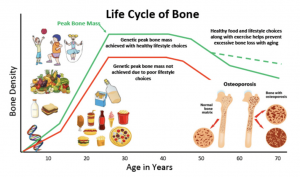The importance of calcium intake for bone development during childhood and adolescence
October 20, 2020

Our next blog is from Kristine Slatten. Kristine Slatten is studying the Master of Nutrition and Population Health at Deakin University and is due to graduate in 2020. The Master’s complements and builds on her Bachelor of Nutrition, Food and Culture from Norway, which is her country of origin. Kristine is passionate about public health with a particular interest in equitable health systems, human food choices and consumption, health behavioural change, and sustainable health outcomes both in humans and the environment. As a part of her degree, Kristine completed an assignment on the effect of calcium supplementation on bone mass development in young females. Some insight from this assignment is shared below.
Bone development during childhood and adolescence
Bone is a living tissue in constant change. Bones grow relatively slowly during childhood but as puberty kicks in, bone development kicks off, resulting in rapid bone growth! The greatest increase in bone mass happens between 12-15 years of age in girls and 14-17 years of age in boys.
Bone growth is influenced by age, gender, genetics, and ethnicity. Generally, males gain more bone mass than females. Bone mass in females is also influenced by the onset of female menstruation and the end of it, called menopause, where reduced hormone levels of oestrogen decreases bone mass.
Our bones continue to grow until late teenage years/early adulthood where they reach a peak in mass and strength (see ‘Peak bone mass’ in Image 1). This ‘peak’ is (theoretically) the strongest and biggest your bones will be – ever!
After this ‘peak’, our bones plateau for a while before they naturally and gradually lose strength and mass – which is one of the reasons why our grandparents appear to be ‘shrinking’.

Image 1. Bone mass development and bone mass loss over the lifespan.
Source: https://spinehealth.org/lifelong-nutrition-for-healthy-bones/
The bad news
As we reach the older years, this gradual loss of bone mass can result in brittle and fragile bones, also known as osteoporosis, where taking a wrong stepcan cause a fall and a fracture.
Although anyone can develop osteoporosis, it is far more common among women. In fact, 29% of women and 10% of men aged 75 years and over had osteoporosis in 2017-18. It is, therefore, particularly important for women to take care of their bones.
The importance of the peak in bone mass
Remember how the greatest bone mass development happens during the ages of 12-17 years? In other words, the strength and health of our bones later in life is mostly determined by our lifestyle and actions during childhood and adolescence.
Think of it like a superfund for retirement. We grow our superfund throughout life to ensure it will sustain us during retirement. It is the same with your peak bone mass: we fill up the ‘bone-bank’ during childhood and adolescence and we live off it for the rest of our life. And like a superfund, we are in trouble if we do not maximise it!
How do we maximise peak bone mass during childhood and adolescence?
Regular weight bearing exercise, Vitamin D through either sun exposure or supplementation, a healthy body weight, and adequate calcium, magnesium, and protein intake are critical factors for optimal bone development (image 2).

Image 2: Protective and beneficial factors for optimum bone growth and maintenance.
Source: https://www.coffeeandhealth.org/media-material/facts-and-figures-5/
Studies of calcium and bone development
So how much calcium is necessary for optimal bone development during childhood and adolescence? Considering osteoporosis is more common among females than males, the studies below examines calcium intake in females.
In one study, 96 girls aged 11-12 years were randomised into two groups for 18 months. The high calcium-intake group of 1174mg per day had a greater increase in bone mass density (the ‘thickness’ of the bone) than the low calcium-intake group of 619mg per day.
A large randomised study included 354 girls aged 10-11 years in a four-years trial, but extended it by another three years, totalling a seven years trial. The high calcium-intake group (1498mg per day) had a greater bone mass increase than the low calcium-intake group (830mg day) at both four and seven years.
What does this mean?
From these two studies, consuming approximately1100-1500mg calcium per day is beneficial for increasing bone mass in young girls.
The recommended intake of calcium and sources in food
Indeed, the Australian Recommended Daily Intake (RDI) for calcium in girls and boys aged 9-18 years is 1000-1300mg calcium
Luckily, there is plenty of calcium in foods! Good sources are dairy products like milk, yoghurt, and cheese. If you cannot drink cow’s milk, try other milk-alternatives with added calcium. Other foods that provide calcium include green leafy vegetables, almonds, and sardines.
Aim to meet the recommended daily serves of dairy foods, so it will ensure an adequate intake of calcium to reach that peak bone mass.